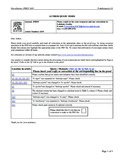Buscar
Mostrando ítems 1-10 de 418
Snake venomics of the pit vipers Porthidium nasutum, Porthidium ophryomegas, and Cerrophidion godmani from Costa Rica: Toxicological and taxonomical insights
(2012-02-16)
Within the Neotropical pit vipers, a lineage of primarily Middle American snake species
referred to as the “Porthidium group” includes the genera Atropoides, Cerrophidion, and
Porthidium. In this study, the venom proteomes ...
Two phospholipase A2 inhibitors from the plasma of Cerrophidion (Bothrops) godmani which selectively inhibit two different group-II phospholipase A2 myotoxins from its own venom: isolation, molecular cloning and biological properties
(2000-03-15)
Myotoxic phospholipases A2 (PLA2s; group II) account for most of the muscle-tissue damage that results from envenomation by viperid snakes. In the venom of the Godman's viper (Cerrophidion godmani, formerly Bothrops godmani), ...
Snake venom components enhance pain upon subcutaneous injection: an initial examination of spinal cord mediators
(2004-09)
Snakebites are a relevant public health problem in Central and South America. Snake bite envenomations cause intense pain, not relieved by anti-venom. The fangs of many species are short, causing subcutaneous injection. ...
Patogénesis y neutralización de los efectos locales inducidos por el veneno de la serpiente "terciopelo" (Bothrops asper).
(1982)
Se presenta la revisión de varias investigaciones sobre la patogénesis y neutralización de los efectos locales inducidos por el veneno de la serpiente terciopelo. El cuadro local está constituido por mionecrosis, hemorragia ...
Snake venomics of monocled cobra (Naja kaouthia) and investigation of human IgG response against venom toxins
(2015-06)
The venom proteome of the monocled cobra, Naja kaouthia, from Thailand, was characterized by RPHPLC,
SDS-PAGE, and MALDI-TOF-TOF analyses, yielding 38 different proteins that were either identified
or assigned to families. ...
Proteomic and functional profiling of the venom of Bothrops ayerbei from Cauca, Colombia, reveals striking interspecific variation with Bothrops asper venom
(Journal of Proteomics Volume 96, 16 January 2014, Pages 159–172, 2014-01)
Bothrops ayerbei, a pitviper inhabiting the Patía River's basin (Valle Alto del Río Patía) in the Southwestern Department of Cauca, Colombia, was considered as a variant form of Bothrops asper prior to being proposed as a ...
Venomic and antivenomic analyses of the Central American coral snake, Micrurus nigrocinctus (Elapidae)
(2011-01-31)
The proteome of the venom of Micrurus nigrocinctus (Central American coral snake) was analyzed by a “venomics” approach. Nearly 50 venom peaks were resolved by RP-HPLC, revealing a complex protein composition. Comparative ...
Stability of equine IgG antivenoms obtained by caprylic acid precipitation: Towards a liquid formulation stable at tropical room temperature
(2009-05)
Liquid formulations of antivenom require a cold chain for their distribution and storage, especially in tropical countries characterized by high temperature and humidity (climatic zone IV). Since cold chain is often deficient ...
Secretory phospholipases A2 isolated from Bothrops asper and from Crotalus durissus terrificus snake venoms induce distinct mechanisms for biosynthesis of prostaglandins E2 and D2 and expression of cyclooxygenases
(2008-09-01)
The effects of myotoxin III (MT-III), a phospholipase A2 (sPLA2) from Bothrops asper snake venom, and crotoxin B (CB), a neurotoxic and myotoxic sPLA2 from the venom of Crotalus durissus terrificus, on cyclooxygenases ...
Neutralizing properties of Varespladib toward group I and II myotoxic phospholipases A2
(2019)
A need exists to develop specific and clinically useful inhibitors of toxic enzymes present in snake venoms,
responsible for severe tissue damage and life-threatening effects occurring in thousands of people suffering
...



